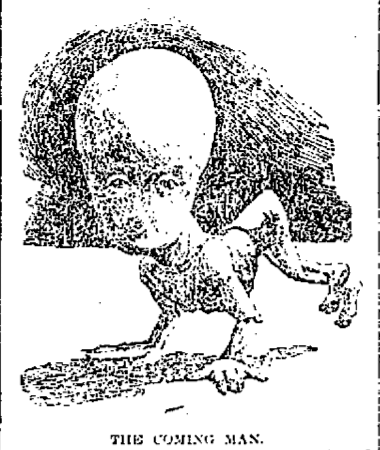
July 27, 2009
1893 “Dover Demon”
© Loren Coleman 2009
Does the above image look familiar to you? It certainly does to me. It resembles the drawings of the Dover Demon seen in Dover, Massachusetts, from April 1977. However, it actually is from a newspaper article published in New York City on December 3, 1893.
This drawing was discovered by Robert Schneck (the author of The President’s Vampire) and shared with me, of course, because of my foundation interest in the Dover Demon. My appreciation to Schneck for bringing this to my attention.
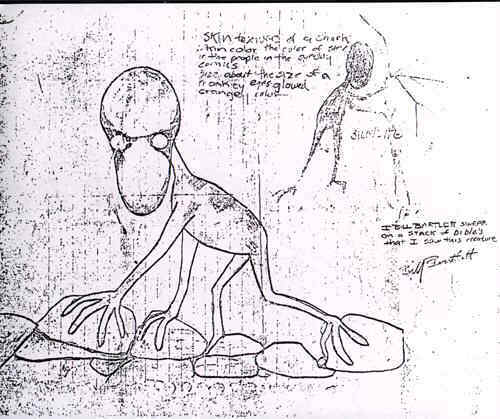
One of Bill Bartlett’s early sketches of the Dover Demon, April 1977.
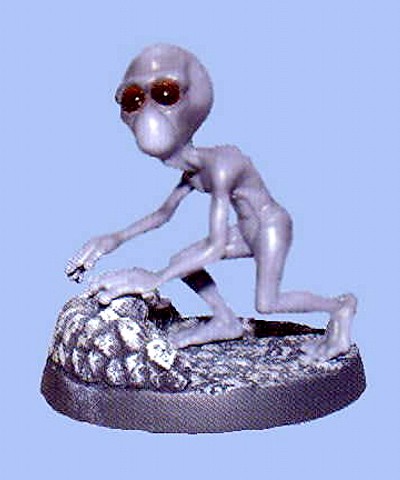
A modern replica of the 1977 Dover Demon sold in Japan.
The 1893 drawing is not of a sighting of any creature, however, but an artist’s (perhaps humorous) imagined illustration of how humans might appear in the future, viewed from the Victorian era. Specifically, the work is tied to the fictional writings of H. G. Wells and his little-known article, “The Man of the Year Million.” It is Wells who has predicted the future of humans will see a diminishing of their hair, nose, teeth, ears, and chin. The above 1893 drawing appears to be an attempt to capture Wells’ thoughts in a bit of newspaper art.
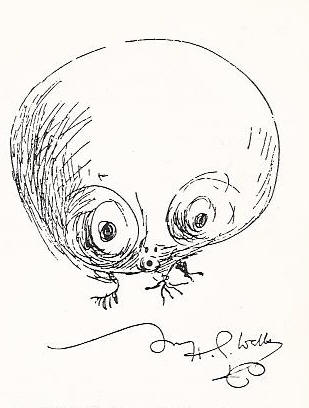
Elsewhere, H. G. Wells’s own sketch of the Man of Tomorrow was once drawn as an autograph. Credit David Szondy.
It is a sad commentary that as a reflection of the man of today, near the 1893 Dover Demon-like drawing, Schneck also found an image from an ad about paid (10¢) viewings of a “wild hairy man.” This was obviously an indigenous person (perhaps from Oceania) in an entertainment sideshow.
Back to the future…
As you may recall (see here from 2007), I remember from the 1950s and 1960s articles on “future humans” that were illustrated with (usually) bald men, the supposed picture of evolved Homo sapiens.
Future men?
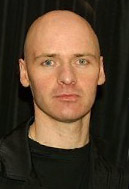
Future man? = blogger author ufologist Nick Redfern.
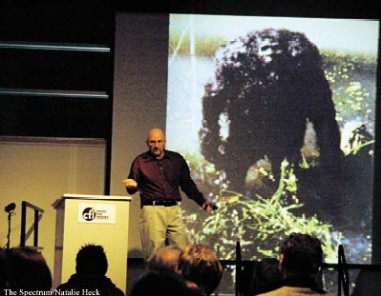
Future man? = debunker editor skeptic Ben Redford.
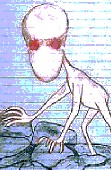
A colored Bill Bartlett drawing of the Dover Demon, 1977.
It is funny to me that Schneck would find this remarkable drawing from 1893, and it would nicely match the drawings that the eyewitnesses had sketched of the Dover Demon in 1977. I am not certain the 1893 treatment mirrors any future version of humans, however.
Please, also, let me be straight. I’m not saying anything about any space-time link between 1893-1977, or time travelers from the future journeying “back” to 1977 Dover. I merely think it’s an interesting coincidence and an outstanding find on Schneck’s part.
While I still maintain that the four eyewitnesses actually saw something extraordinary in 1977, which cannot be explained by mundane species, I do not know what the Dover Demon was or is. It remains the most unusual of the unexplained unknowns in my files of Fortean creatures, which appear to overlap into cryptozoology. After all, the Dover Demon is a cryptid, an unknown animal, apparently, seen in rather normal settings of rural Massachusetts.
The 1893 article…
Robert Schneck has painstakingly transcribed the news item and writes, “The article is hard to read but it’s written with heavy-handed humor that presumably went over big in 1893.”
The World, New York City, New York, December 3, 1893.
MAN IN THE YEAR MILLION
———
Look at the Picture Below and You Will See What the Human Race Is Coming To.
———
AN INORDINATE CASE OF SWELLED HEAD.Somebody in the Pall Mall Budget has let his fancy take wings in the contemplation of the time when all of the _____ _____ in these United States will be anything but humanity.
This ______ ‘s theme is the “Man of the Year Million.” And, judging from the accompanying picture, it will take about that long to complete the change. There is comfort in the thought that there is some little time ahead for good-looking fellows.
In his introduction this writer says: “Accomplished literature is all very well in its way, but much more fascinating to the contemplative man are the books that have not been written. These latter are no trouble to hold; there are no pages to turn over. One can read them in bed on sleepless nights without a candle.”
One of the unwritten volumes is a big book by Prof. Holzkopf, of the University of Weissnichtwo, on “The Necessary Character of the Man of the Remote Future. Deduced from the Existing Stream of Tendency.”
Just as the bird is the creature of the wing, and is moulded and modified for flying, so man is a creature of brain, and must live by that and not by physical strength. Naturally, then, that which is animal in him must gradually disappear as civilization more and more, becomes a fixed habit. He doesn’t need big muscles to get a living; nor big jaws to seize his food and crush it. His jaws get smaller, his teeth and hair are soon lost; trains and trolley cars render speed unnecessary; he doesn’t have to hunt his wife. She hunts him. Wit, and not strength. Is what he needs. Hence the legs will shrink up and the head swell.
Science gives him the knife and fork. There is no reason why it should not masticate and insalivate his food. Does it now digest it with all the pepsin compounds? Teeth will disappear.
The eyebrow used to be a buffer to protect the eye from savage blows. Once exterminate football and the ridge of bone over the eye will go the way of the hair on the pate.
In some of the most highly developed crustaceans, the whole alimentary canal has solidified into a useless cord, because the animal is nourished by the food in which it swims. The man of the year million will not be bothered with servants handing him things on plates which he will chew, and swallow and digest. He will bathe in amber liquid which will be pure food, no waste matter assimilated through the pores of the skin. The mouth will shrink to a rosebud thing; the teeth will disappear; the nose will disappear-it is not nearly as big now as it was in savage days-the ears will go away. They are already folded up from what they were, and only a little tip fast vanishing remains to show that ages ago they were long-pointed things which bent forward and backward to catch the sound of approaching enemies.
But the brains grow, for they are exponents of the brain, and the great soulful eyes.
Prof. Holzkopf goes on to that gloomy time when all animal life shall have been superseded by mechanical contrivances, on to the time when the earth cools and the human tadpoles burrow in the earth for warmth.
But the year million is far enough away, isn’t it?
© Loren Coleman 2009 (when noting this discussion, also please mention the discoverer of the 1893 illustration, Robert Schneck, the author of The President’s Vampire).
About Loren Coleman
Loren Coleman is one of the world’s leading cryptozoologists, some say “the” leading living cryptozoologist. Certainly, he is acknowledged as the current living American researcher and writer who has most popularized cryptozoology in the late 20th and early 21st centuries.
Starting his fieldwork and investigations in 1960, after traveling and trekking extensively in pursuit of cryptozoological mysteries, Coleman began writing to share his experiences in 1969. An honorary member of Ivan T. Sanderson’s Society for the Investigation of the Unexplained in the 1970s, Coleman has been bestowed with similar honorary memberships of the North Idaho College Cryptozoology Club in 1983, and in subsequent years, that of the British Columbia Scientific Cryptozoology Club, CryptoSafari International, and other international organizations. He was also a Life Member and Benefactor of the International Society of Cryptozoology (now-defunct).
Loren Coleman’s daily blog, as a member of the Cryptomundo Team, served as an ongoing avenue of communication for the ever-growing body of cryptozoo news from 2005 through 2013. He returned as an infrequent contributor beginning Halloween week of 2015.
Coleman is the founder in 2003, and current director of the International Cryptozoology Museum in Portland, Maine.
Filed under Cryptomundo Exclusive, CryptoZoo News, Dover Demon, Media Appearances, Twilight Language, Year In Review